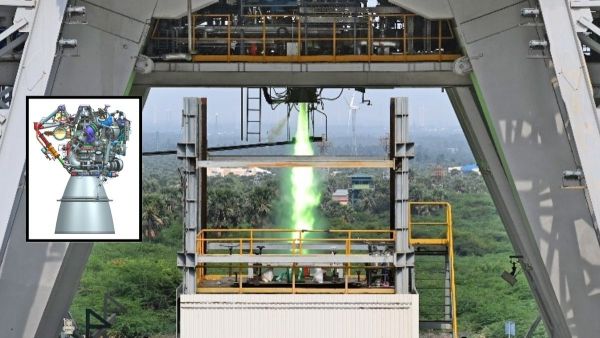
ISRO is achieving progress in the design and development of a semi-cryogenic engine or Liquid Oxygen or Kerosene engine with a high thrust of 2000kN that will power the semi-cryogenic booster stage of the LVM3 launch vehicle. The first major breakthrough in the Semicryogenic engine development programme was achieved on March 28, 2025, when the first successful hot test of the Engine Power Head Test Article (PHTA), was carried out at ISRO Propulsion Complex, Mahendragiri, Tamil Nadu.
ISRO has made significant strides in developing indigenous cryogenic and semi-cryogenic engine technology, with recent tests demonstrating India’s growing capabilities in advanced rocket propulsion systems. The technological progress in this field indicates a global shift toward more sustainable and capable propulsion systems that can support increasingly complex space mission profiles in the coming decades.
The semicryogenic engine is a game-changer for India’s space program. Unlike older engines that use less efficient fuels, this new technology delivers more power.
Once fully developed, it will be used in the Launch Vehicle Mark 3 (LVM3), India’s most powerful rocket. Right now, the LVM3 can carry about 4 tonnes (4,000 kilograms) of payload—like satellites—into a Geosynchronous Transfer Orbit (GTO), a key orbit for communication satellites.
With the semicryogenic engine, this capacity will jump to over 5 tonnes. That’s an extra 1,000kg—an increase that opens up new possibilities for India.
In parallel with semi-cryogenic development, ISRO has continued to advance its cryogenic engine technology. In February 2025, ISRO successfully conducted an ignition trial of the indigenous CE20 cryogenic engine that powers the upper stage of the Launch Vehicle Mark-III (LVM-III).
This test was particularly significant as it was conducted in vacuum conditions, accurately simulating the environment the engine experiences during actual spaceflight after the initial stages are jettisoned. The test took place at the High Altitude Test Facility at ISRO Propulsion Complex in Mahendragiri, Tamil Nadu, demonstrating ISRO’s capability to test advanced propulsion systems in specialized environments.
Most recently, on March 14, 2025, ISRO completed a flight acceptance hot test of the cryogenic engine designated for the sixth operational mission of the LVM3 launch vehicle (LVM3-M6).
This test represents a standard procedure in ISRO’s rigorous quality control process, where cryogenic engines for each mission undergo hot testing as part of their flight acceptance protocol.
Previously, hot tests for the indigenous CE20 cryogenic engine were conducted at the High-Altitude Test facility with test duration limited to 25 seconds due to the complexity of simulating vacuum conditions.
The semicryogenic engine is a game-changer for India’s space program. Unlike older engines that use less efficient fuels, this new technology delivers more power.
“Once fully developed, it will be used in the Launch Vehicle Mark 3 (LVM3), India’s most powerful rocket. Right now, the LVM3 can carry about 4 tonnes (4,000kg) of payload—like satellites—into a Geosynchronous Transfer Orbit (GTO), a key orbit for communication satellites. With the semicryogenic engine, this capacity will jump to over 5 tonnes. That’s an extra 1,000kg an increase that opens up new possibilities for India,” explained space expert Girish Linganna.
This breakthrough will supercharge India’s space ambitions. A stronger LVM3 means ISRO can launch heavier satellites for communication, weather monitoring, and navigation—all critical for modern life. It also makes India more competitive in the global space market, where countries and companies pay to launch their satellites. With lower costs and greater reliability, India could attract more international customers, boosting its economy.
Beyond commercial launches, this technology strengthens India’s ability to explore space.
“Heavier payloads mean more advanced scientific missions, like sending bigger probes to the Moon, Mars, or even beyond. It also supports India’s plans for human spaceflight under the Gaganyaan program, as a more powerful rocket can carry the equipment and supplies needed for astronauts,” added Linganna.
Other countries that have developed and used semi-cryogenic engine technology include the United States, Russia, China, and Japan.
Russia has been a pioneer in semi-cryogenic propulsion, with engines like the RD-180 and RD-170 series powering vehicles such as the Atlas V and Zenit rockets. The United States has also utilised semi-cryogenic engines, including the use of the RD-180 in the Atlas V rocket.
China has been actively developing its own semi-cryogenic engines, such as the YF-100, which powers the Long March 5 and Long March 7 rockets. Japan has also explored semi-cryogenic technology as part of its evolving launch vehicle programs.
These nations have contributed to the global advancement of semi-cryogenic propulsion, recognizing its advantages in cost-effectiveness, efficiency, and thrust capability. The technological progress in this field suggests a continued global emphasis on advanced propulsion systems, positioning semi-cryogenic engines as a crucial component of future space missions.
“The development of semi-cryogenic engines using liquid oxygen and kerosene represents a strategic move toward more efficient, powerful, and cost-effective launch systems. These efforts align with similar developments by other major space agencies worldwide, including NASA, ESA, Roscosmos, CNSA, and JAXA, who continue to advance cryogenic propulsion technology to support their ambitious space exploration goals,” explained Srimathy Kesan, founder and CEO of Space Kidz India.
For everyday Indians, this achievement is a source of pride and a promise of progress. Better satellites mean improved internet, TV, weather forecasts, and disaster warnings—things that touch millions of lives. For the world, it’s a sign that India’s space program is here to stay, offering affordable and reliable access to space.